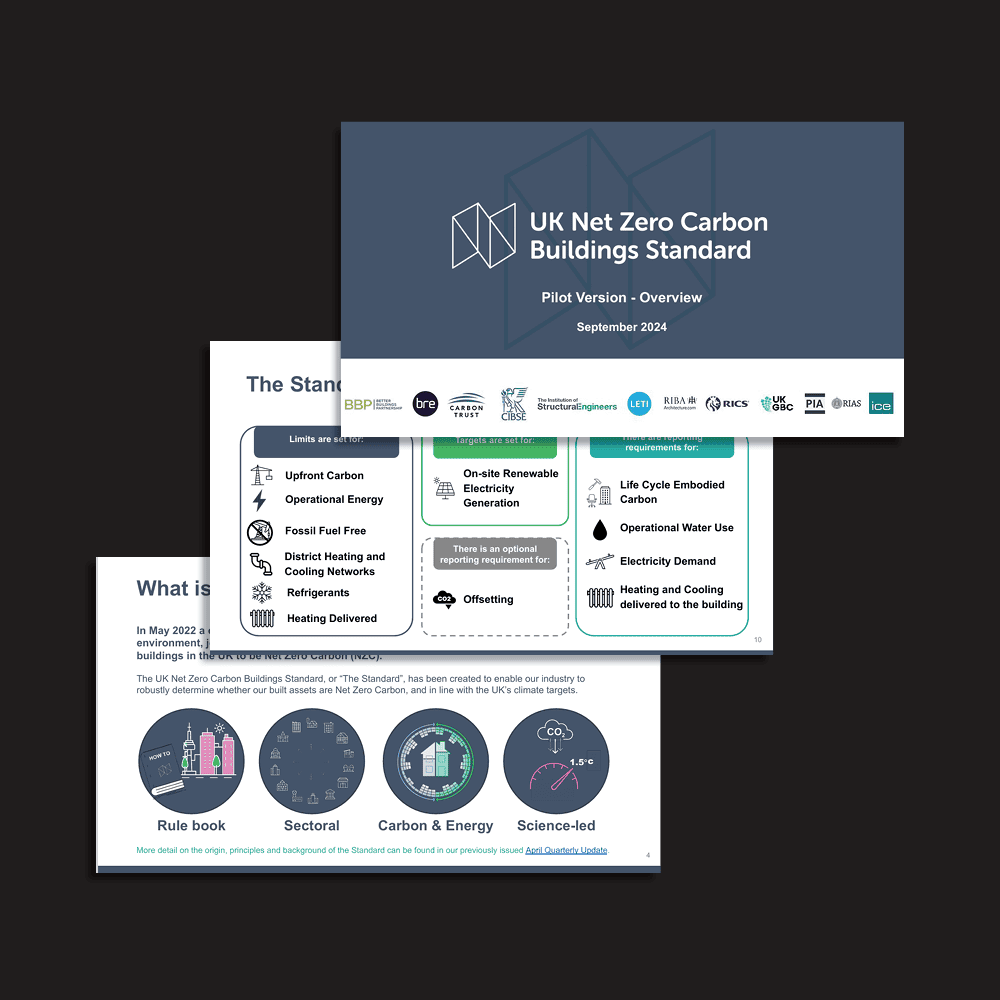NZWLC Industry Pulse Check: Whole life carbon measurements and agreed limits

Industry Pulse Check
This publication forms part of a series called the Industry Pulse Check, a periodic report on the built environment sector’s progress in reducing emissions in line with the Net Zero Whole Life Carbon Roadmap. Each publication highlights areas where the industry has made strides on the priority actions identified in the Roadmap and where it is falling short. It identifies stakeholders responsible for essential future actions and features voices of industry professionals urging the sector to elevate its efforts.
Embodied carbon emissions account for approximately 50% of lifecycle emissions for new builds, yet they remain unregulated, and measurement and mitigation within design and construction is mostly voluntary. As a significant contributor to the UK’s total greenhouse gas emissions, embodied carbon must be tackled in order to meet the UK’s carbon budgets.
Addressing this issue requires a dual approach: enhancing design efficiency and optimising material choices by building designers, while also decarbonising the supply chain through industrial strategies and carbon pricing policies. The development of the UK building stock should prioritise a “retrofit first” strategy, driving the circular economy, fostering second-hand materials markets, and increasing re-use.
The development of the UK building stock should prioritise a “retrofit first” strategy, driving the circular economy, fostering second-hand materials markets, and increasing re-use.
Will Arnold, Head of Climate Action at The Institution of Structural Engineers, said:
Recent years have seen significant voluntary action on whole life carbon from across the sector. Guidance, tools and training continues to increase the capacity of project teams to understand and reduce the carbon emissions from their designs. Exemplary projects touch the ground more lightly each year, and the launch of the 1.5°-aligned UK Net Zero Carbon Buildings Standard provides the watermark against which such projects can be judged.
The challenge now is to ensure the take-up of such skills across every project, not only the exemplars. The time is right for whole life carbon regulation to be introduced, bringing industry-wide consistency on reporting requirements, and levelling the playing field between projects. Experts have been calling for such regulation since 2007, and the 200+ statements of support shown on the Part Z website demonstrate wide backing from industry.”
What is the industry doing about Whole Life Carbon?
The industry is beginning to shift its approach to decarbonisation, driven by an improved knowledge and awareness of whole life carbon and the urgent need to reduce embodied carbon emissions. Leading private companies, industry organisations, and local authorities have been taking initial steps in this area by setting operational energy and upfront embodied carbon targets, demonstrating a commitment and drive to reduce emissions associated with development.
Currently, the measurement and mitigation of embodied carbon at project level is voluntary, with regulatory or statutory mechanisms only in place in a handful of local authorities. While leading developers and infrastructure clients measure and optimise the embodied carbon footprint of new projects, and technical standards and guidance are available to support this, this practice is not yet mainstream across the industry.

New standards to support Whole Life Carbon reductions
In July 2024, the Royal Institution of Chartered Surveyors (RICS) introduced the Whole Life Carbon Assessment Professional Standard, updating the previous 2017 Professional Statement. The new Standard sets a high bar for consistency and reliability in whole life carbon modelling and reporting. To advance further the industry needs to collectively contribute their whole life carbon data to open-access resources, such as the Built Environment Carbon Database (BECD). Shared and accessible data is vital for further informed target-setting, decision-making and industry-wide improvement.
Industry organisations have also played a pivotal role in advancing the decarbonisation mandate through the development of the UK Net Zero Carbon Buildings Standard, a landmark initiative which established limits that align with the 1.5°C global heating threshold set by the Paris Agreement. The Standard provides clear, time-bound limits for upfront embodied carbon, creating a definitive pathway for industry to align with a 1.5°C heating scenario. The industry’s collaboration in creating this standard underscores the shared understanding of the urgent need to address climate change and willingness to lead by example.
Advocating for legislative support
The Part Z campaign, driven by industry advocates, continues to push for mandatory whole life carbon measurements and upfront embodied carbon limits to be included in UK building regulations. This campaign highlights the necessity of legislative support to drive widespread adoption and ensure that carbon considerations are part of every stage of a building’s lifecycle. Many leading companies and organisations support this campaign, recognising that regulatory frameworks are essential for achieving systemic change.
We need government policy on Whole Life Carbon
robust action from the national government is critical to bring the rest of the industry up to speed
Despite these advancements, robust action from the national government is critical to bring the rest of the industry up to speed. This requires mandating whole life carbon assessments in building regulations and ultimately introducing legal limits to upfront embodied carbon, with a view to future revision and tightening as required. Without such intervention, the progress made by leading companies and organisations may not be enough to drive the widespread, systemic change required to meet the UK’s carbon reduction targets.
Local authorities leading by example
Several local authorities, including the Greater London Authority, Milton Keynes City Council, Bath & North-East Somerset Council, and Southampton City Council, have taken commendable steps to incorporate whole life carbon measurements and limits into their planning requirements. These actions set a benchmark for other regions and demonstrate the potential for local governance to drive progress at a regional level.
Alex Benstead, Senior Advisor at UKGBC, said:
With the urgent need to cap global temperature increases at 1.5°C, it’s alarming that around 1 in 10 tonnes of the UK’s total greenhouse gas emissions, specifically those related to embodied carbon, remain unregulated. We need responsible government action to mandate whole life carbon measurement in building regulations and introduce legal limits on embodied carbon.
This is crucial for supporting ongoing positive actions. Industry consultants are constantly improving the consistency and reliability of their carbon modelling and reporting. Several Local Authorities are leading by example, incorporating whole life carbon measurements and limits into their planning requirements. Now bold steps need to be taken to mainstream these practices.”
Stakeholder Action Plans
The Whole Life Carbon Roadmap includes 14 individual Stakeholder Action Plans that set out specific recommended actions for key industry stakeholders. These plans enable stakeholders to contribute effectively to achieving the Roadmap’s goals. Below is a summary table of the actions related to this Key Priority: Whole Life Carbon Measurement and Agreed Limits.
To learn more about the Stakeholder Action Plans, join our unique collaborative programme with our membership to drive greater action, and understand the industry status on delivery of the actions within the plans – where are we and what more do we need to do?
Stakeholder Action Plans
Initial Actions:
Support use of Whole Life Carbon (WLC) (and other environmental impacts) as design criteria and to drive design decisions.
Adopt and promote standard metrics for monitoring and reporting embodied carbon (for both buildings and infrastructure projects). Establish a requirement for use of EPD databases in the design process
Establish a central database (Built Environment Carbon Database (BECD)) for embodied carbon (asset and product level) to gather data across the industry, standardise inputs, and help set benchmarks and targets per sector.
Set strategy for asset level Net Zero Carbon (NZC) verification and / or certification scheme.
Green Certification Schemes such as CEEQUAL and BREEAM update minimum standards for highest rating levels to align with industry NZC metrics for operational energy performance and embodied carbon (i.e. shift to absolute performance metrics instead of comparison studies).
All industry awards to mandate disclosure of carbon / energy, with consideration as part of judging.
Action Progress by 2025
Verification and / or certification scheme for NZC buildings established, to include operational and embodied carbon performance standards.
Green Building Certification Schemes aligned with net zero carbon targets.
Action Progress by 2030
NZC performance standards to be reviewed as required to ensure they align with sector carbon budgets.
Initial Actions:
Include operational energy performance and embodied carbon targets in project funding criteria.
Develop stricter guidance on what constitutes a net zero non-domestic building for the purpose of lending, based on the UKGBC Net Zero Carbon Buildings Framework Definition.
Action Progress by 2025:
Mandate operational energy and embodied carbon targets in project funding criteria.
Begin offering preferential borrowing rates for low to zero carbon retrofits that actively demonstrate how they reduce Whole Life Carbon.
Action Progress by 2030:
Project funding criteria based on validated past performance of projects, as well as targets for the project seeking funding.
Initial Actions:
Establish Whole Life Carbon (WLC) as a first order consideration within initial site development appraisals and decision-making and prioritise refurbishment / extension over demolition and new build
Establish a NZC client brief on all development projects which:
- Embeds an outcome-focused “design for performance” approach through design and procurement.
- Sets targets for energy intensity metrics for all projects in line with industry / sector targets.
- Sets embodied carbon targets (A1-A5 and A-C) and material re-use targets.
- Establishes WLC as a primary decision-making metric to be evaluated at each RIBA Stage
Action Progress by 2025:
Embed carbon reduction metrics within corporate KPIs and executive remuneration mechanisms.
Assess, as standard, development appraisals with WLC impacts as key determinant i.e. prioritise brownfield development, sustainable transport solutions, and local economies.
Track progress of completed projects against energy
intensity and embodied carbon targets, with as built and in-use verification in place to limit any performance gap.
Aim for at least 40% of products and materials used in building projects to have EPDs.
Action Progress by 2030:
Progressive tightening of targets in line with net zero trajectories and industry carbon budgets.
Aim for 100% of products and materials used in building projects to have EPDs (with suitable minimum thresholds).
Initial Actions:
Social landlords to establish current carbon footprint, accounting for operational in-use and embodied carbon impacts (i.e. maintenance and repair).
Action Progress by 2025:
Disclose embodied carbon impacts of in-use life-cycle stages (i.e. servicing / maintenance arrangements) to better understand EN15978 lifecycle stages B1-B5 (in use) including refrigerant leakage, and feed data into relevant public databases (i.e. Built Environment Carbon Database (BECD)).
Action Progress by 2030:
Provide annual public carbon reporting for retrofit, replacement and maintenance work alongside operational energy / carbon reporting from 2025 onwards. Feed data into relevant public database (i.e. BECD).
Initial Actions:
Establish a NZC occupier brief for all fit-out projects (and any new builds) including targets for embodied carbon and tenant energy intensity in line with industry targets.
Ensure embodied carbon assessments are undertaken on major fit-out projects and internal works, and begin sharing embodied carbon data with landlord / developer and industry carbon databases (Built Environment Carbon Database (BECD)) to support development of industry targets.
Action Progress by 2025:
Commit to NZC fit out targets on all Full Repairing and Insuring leases.
Provide embodied carbon assessment data for all projects to carbon database (BECD).
Action Progress by 2030:
All fit outs achieve NZC targets for energy intensity and embodied carbon.
Initial Actions:
Incorporate data associated with operational carbon, embodied carbon, and building / infrastructure lifecycles within the ongoing management of existing / future assets to drive low carbon decisions.
Share learnings from maintaining / operating net zero assets to inform future projects and retrofits, including the submission of operational and embodied carbon data into a centralised database to inform new projects.
Action Progress by 2025:
Managers are advocates for NZC buildings.
Initial Actions:
Work with supply chain to set operational and embodied carbon reduction targets, require mandatory disclosure of supply chain data, track construction site emissions, and request EPDs (EPD A-D to EN15804 & externally verified) from all supply chains (driving towards 40% of all products, in terms of carbon impact, by 2025).
Include carbon reduction targets and reporting commitments explicitly in all documents, as a deliverable of the construction process, using PAS 2080 (or equivalent standard)
Tier 1 contractors to achieve verification of their carbon management processes to PAS 2080, or have a verified carbon management and reduction plan accredited to ISO14064 or equivalent.
Action Progress by 2025:
EPDs declared for 40% of construction materials and products used in supply chain.
Share ‘good/best practice’ case studies from using PAS2080. 80% of projects achieve PAS 2080 verification (or equivalent standard).
Action Progress by 2030:
All contractors have declared 100% of supply chain products and materials via EPDs. i.e. 100% EPD by 2030 (with suitable minimum thresholds).
100% of projects achieve PAS 2080 verification (or equivalent standard).
Initial Actions:
All manufacturers begin developing EPDs for product portfolio, aiming for a minimum of A1-A5 + C + D (EN15804 and externally verified) and working towards 40% of their standard product portfolio (in terms of embodied carbon impact) by 2025, with minimum thresholds and support and subsidies for SMEs.
Contribute to central industry database (BECD) capturing embodied carbon at product level through EPDs (EPD A-D to EN15804 & externally verified).
Action Progress by 2025:
All manufacturers have declared the embodied carbon of the top 40% of their standard product portfolio via EPDs.
Develop material passport standards, tools and databases, with support of industry bodies.
Action Progress by 2030:
All manufacturers have declared their entire standard product portfolios via EPDs. i.e. 100% EPD by 2030 (with suitable minimum thresholds).
Material passports established and adopted by industry.
Initial Actions:
Carry out high level Whole Life Carbon (WLC) estimates as part of initial site appraisals (refurb / extend / new build), identify and advocate for lowest carbon development options. Wherever possible, advocate and design for re-use and retention of existing building structure / substructure.
Establish energy intensity and embodied carbon targets in project briefs for all projects in line with industry / sector targets.
Action Progress by 2025:
WLC assessments and carbon impacts used as the key driver to inform design strategies throughout the project lifecycle (RIBA stages 0-7).
Provide clients with low carbon or NZC design options as standard at early design stages.
Contribute towards achieving energy intensity and embodied carbon targets for majority of projects, with as built and in-use verification in place to limit any performance gap.
Initial Actions:
Improve understanding of WLC impact of typical MEP installations, build capacity in undertaking WLC assessments, and push supply chains to provide EPDs (EPD A-D to EN15804 & externally verified) and improved embodied carbon data.
Adopt and support the development of industry project targets and commit to presenting design options for how these can be achieved on all projects.
Commit to identifying the lowest WLC approach for every project.
Action Progress by 2025:
Carry out embodied carbon assessments of building services systems on all projects through all RIBA stages, to inform design and procurement, and contribute to achieving industry targets for embodied carbon intensity.
Ensure all designs are as a minimum ‘net zero ready’ – with planned upgrade pathways identified to avoid significant future retrofit and minimise WLC.
Champion the lowest WLC approaches on all projects.
Action Progress by 2030:
Low embodied carbon MEP design and specification becomes standard practice.
Initial Actions:
Build capacity in undertaking embodied carbon assessments using industry tools to elevate competencies and enhance quality of structural embodied carbon assessments.
Undertake and present embodied carbon estimates for different structural solutions at concept design stage on all projects.
Action Progress by 2025:
Elevated industry competence and skills in embodied carbon assessment of structural designs across all building types.
Embodied carbon assessments carried out for structural design on all projects through all RIBA design stages as one of the primary decision tools in design and procurement. Contribute to achieving industry targets for embodied carbon intensity.
Action Progress by 2030:
Low embodied carbon structural design and specification becomes standard practice.
Initial Actions:
Provide a carbon baseline for all projects by adopting PAS 2080 and set targets for carbon reduction against these, driving innovation. Include, where appropriate, financial incentives to ensure targets are met.
Share carbon data openly via industry-wide central embodied carbon database (Built Environment Carbon Database (BECD)).
Action Progress by 2025:
Implement approaches to improve capabilities to measure and reduce embodied and operational carbon over the whole lifecycle of the asset and ensure carbon reduction targets remain progressive over time with industry advancements.
Commit to using an agreed industry-wide set of carbon emission factors for construction products and buildings materials that are used consistently across all infrastructure projects.
Initial Actions:
Include carbon reduction targets and reporting commitments in project briefs as deliverables of the design. Use PAS 2080 (or equivalent standard) as the reference document for this.
Share carbon reduction data openly via industry-wide central embodied carbon database (Built Environment Carbon Database (BECD)) for the purposes of benchmarking and performance improvement, and commit to sharing own best practice across the supply chain / sectors and learning from and adopting others best practice where possible.
Action Progress by 2025:
Commit to using an agreed industry-wide set of carbon emission factors for construction products and buildings materials that are used consistently across all infrastructure projects.
Action Progress by 2030:
All projects use an agreed industry-wide set of carbon emission factors.
Initial Actions:
Proactively recommend and adopt carbon measurement and carbon reduction methodologies in all projects for both design and construction, regardless of whether clients are requesting them. Use PAS 2080 (or equivalent standard as the reference document).
Conduct Whole Life Carbon (WLC) assessments for all projects above £10m.
Contribute carbon reduction data to an industry-wide central carbon database (Built Environment Carbon Database (BECD)) for the purposes of benchmarking and performance improvement, and to sharing own best practice across the supply chain / sectors and learning from and adopting others best practice where possible.
Automate production and delivery of CO2 e information through design and construction by using integrated approaches to data creation and management. This will inform optimal solutions through the build phase and streamline delivery of information to clients.
Action Progress by 2025:
Conduct WLC assessments for all projects above £5m.
Action Progress by 2030:
Conduct WLC assessments for all projects.
Related
The Whole Life Carbon Roadmap – 4 Key Findings You Might Have Missed

The Whole Life Carbon Roadmap – Answering your data FAQs received to date

UKGBC launches the UK Climate Resilience Roadmap

UKGBC responds to the Climate Change Committee’s 2025 Progress Report



